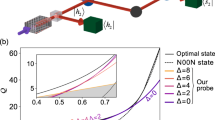Abstract
The parameters at which the maximally entangled two-particle state appears in the system of two ideal electronic Mach-Zehnder interferometers are known. In this work, the operation of nonideal devices with finite scattering in splitters and with reflection in the region of the Coulomb Interaction has been considered. It has been shown that, under the condition of postselection of experimental results, these factors can increase the observed Bell parameter to values exceeding Cirel’son’s (or Tsirelson’s) bound equal to 2√2 up to the mathematical limit equal to 4. A simple postselective measurement scheme providing B = 4 has been described. Although the results of such measurements are not as fundamental as the observation of the violation of Bell’s inequality, they can indirectly indicate the existence of an entangled state in the system. The measurement system is more stable against fluctuations of the phase than a system without postselection. Furthermore, it has been found that the proposed system is optimal for investigation of cross correlations between interferometers in the dc regime (beyond the paradigm of the violation of Bell’s inequality) because they cannot be generated by coordinated fluctuations of Aharonov-Bohm phases.
Similar content being viewed by others
References
A. Einstein, B. Podolsky, and N. Rosen, Phys. Rev. 47, 777 (1935).
E. Shrodinger, Naturwissensch. 23, 807 (1935).
J. S. Bell, Phys. 1, 195 (1964).
J. F. Clauser, M. A. Horne, A. Shimony, and R. A. Holt, Phys. Rev. Lett. 23, 880 (1969).
B. Tsirelson, Lett. Math. Phys. 4, 93 (1980).
A. Aspect, P. Grangier, and G. Roger, Phys. Rev. Lett. 49, 91 (1982).
G. Lesovik, T. Martin, and G. Blatter, Eur. Phys. J. B 24, 287 (2001).
P. Recher, E. Sukhorukov, and D. Loss, Phys. Rev. B 63, 165314 (2001).
L. Hofstetter, S. Csonka, J. Nygard, and C. Schönenberger, Nature 461, 960 (2009); J. Wei and V. Chandrasekhar, Nature Phys. 6, 494 (2010); A. Das, Y. Ronen, M. Heiblum, et al., Nature Commun. 3, 1165 (2012).
Y. Ji, Y. Chung, D. Sprinzak, et al., Nature 422, 415 (2003).
P. Roulleau, F. Portier, D. C. Glattli, et al., Phys. Rev. B 76, 161309 (2007).
I. Neder, N. Ofek, Y. Chung, et al., Nature 448, 333 (2007).
I. Neder, M. Heiblum, D. Mahalu, and V. Umansky, Phys. Rev. Lett. 98, 036803 (2007).
C. W. J. Beenakker, C. Emary, M. Kindermann, and I. L. van Velsen, Phys. Rev. Lett. 91, 147901 (2003).
P. Samuelsson, E. V. Sukhorukov, and M. Büttiker, Phys. Rev. Lett. 91, 157002 (2003); Phys. Rev. Lett. 92, 026805 (2004).
K. Kang and K. H. Lee, Physica E 40, 1395 (2008).
J. Dressel, Y. Choi, and A. N. Jordan, Phys. Rev. B 85, 045320 (2012).
A. A. Vyshnevyy, G. B. Lesovik, and T. Martin, Phys. Rev. B 87, 165417 (2013).
L. S. Levitov, H. Lee, and G. B. Lesovik, J. Math. Phys. 37, 4845 (1996).
A. V. Lebedev, G. B. Lesovik, and G. Blatter, Phys. Rev. B 72, 245314 (2005).
J. Keeling, I. Klich, and L. S. Levitov, Phys. Rev. Lett. 97, 116403 (2006).
F. Hassler, B. Kung, G. B. Lesovik, and G. Blatter, AIP Conf. Proc. 1134, 113 (2008).
G. Fève, A. Mahé, J.-M. Berroir, et al., Science 316, 1169 (2007).
A. A. Vyshnevyy, A. V. Lebedev, G. B. Lesovik, and J. Blatter, Phys. Rev. B 87, 165302 (2013).
D. W. Berry, H. Jeong, M. Stobinska, and T. C. Ralph, Phys. Rev. A 81, 012109 (2010).
Author information
Authors and Affiliations
Corresponding author
Additional information
Original Russian Text © A.A. Vishnevyy, G.B. Lesovik, 2013, published in Pis’ma v Zhurnal Eksperimental’noi i Teoreticheskoi Fiziki, 2013, Vol. 98, No. 8, pp. 565–572.
Rights and permissions
About this article
Cite this article
Vishnevyy, A.A., Lesovik, G.B. Postselective measurement of the electronic entanglement in the system of two Mach-Zehnder interferometers with coulomb interaction. Jetp Lett. 98, 507–513 (2013). https://doi.org/10.1134/S0021364013210157
Received:
Published:
Issue Date:
DOI: https://doi.org/10.1134/S0021364013210157




